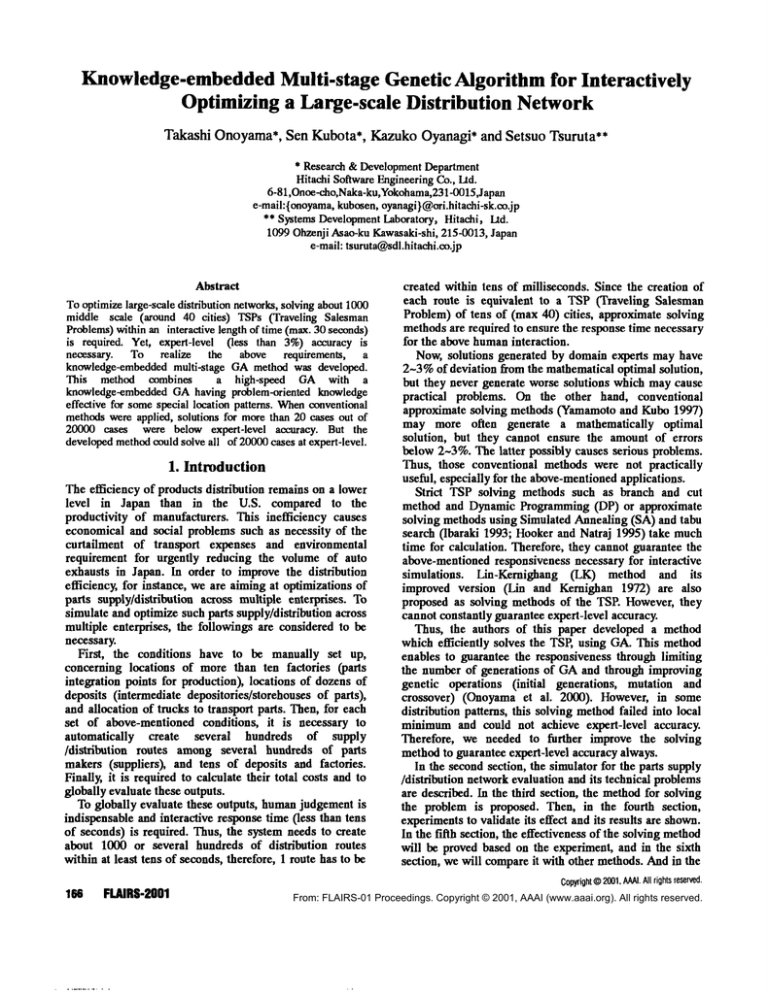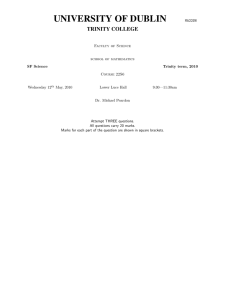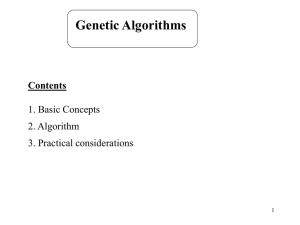
Knowledge-embedded
Multi-stage Genetic Algorithm for Interactively
Optimizing a Large-scale Distribution Network
Takashi Onoyama*,Sen Kubota*, KazukoOyanagi*and Setsuo Tsuruta**
* Research &DevelopmentDepartment
Hitachi SoftwareEngineeringCo., Ltd.
6-81,0noe-cho, Naka-ku,Yokohama,231-0015,Japan
e-maih{onoyama,
kubosen,oyanagi}@ori.hitachi-sk.co.jp
** SystemsDevelopment
Laboratory, Hitachi, Ltd.
1099Ohzenji Asao-kuKawasaki-shi,215-0013,Japan
e-maihtsuruta@sdl.hitachi.co.jp
Abstract
Tooptimizelarge-scale distribution networks,solvingabout1000
middle scale (around 40 cities) TSPs (Traveling Salesman
Problems)within an interactive length of time (max.30 seconds)
is required. Yet, expert-level (less than 3%) accuracy
necessary. To realize the above requirements,
a
knowledge-embedded
multi-stage GAmethodwas developed.
This method combines
a high-speed GA with a
knowledge-embedded
GAhaving problem-oriented knowledge
effective for somespecial location patterns. Whenconventional
methodswere applied, solutions for morethan 20 cases out of
20000 cases were below expert-level accuracy. But the
developedmethodcould solve all of 20000cases at expert-level.
1. Introduction
The efficiency of products distribution remains on a lower
level in Japan than in the U.S. compared to the
productivity of manufacturers. This inefficiency causes
economical and social problems such as necessity of the
curtailment of transport expenses and environmental
requirement for urgently reducing the volume of auto
exhausts in Japan. In order to improve the distribution
efficiency, for instance, we are aimingat optimizations of
parts supply/distribution across multiple enterprises. To
simulate and optimize such parts supply/distribution across
multiple enterprises, the followings are considered to be
necessary.
First, the conditions have to be manually set up,
concerning locations of more than ten factories (parts
integration points for production), locations of dozens of
deposits (intermediate depositories/storehouses of parts),
and allocation of trucks to transport parts. Then, for each
set of above-mentioned conditions, it is necessary to
automatically
create several hundreds of supply
/distribution
routes amongseveral hundreds of parts
makers (suppliers), and tens of deposits and factories.
Finally, it is required to calculate their total costs and to
globally evaluate these outputs.
To globally evaluate these outputs, humanjudgement is
indispensable and interactive response time (less than tens
of seconds) is required. Thus, the system needs to create
about 1000 or several hundreds of distribution routes
within at least tens of seconds, therefore, 1 route has to be
166 FLAIRS-20Ol
created within tens of milliseconds. Since the creation of
each route is equivalent to a TSP (Traveling Salesman
Problem) of tens of (max 40) cities, approximate solving
methodsare required to ensure the response time necessary
for the above humaninteraction.
Now, solutions generated by domain experts may have
2-3%of deviation from the mathematicaloptimal solution,
but they never generate worse solutions which maycause
practical problems. On the other hand, conventional
approximate solving methods (Yamamotoand Kubo 1997)
may more often generate a mathematically optimal
solution, but they cannot ensure the amount of errors
below 2-3%. The latter possibly causes serious problems.
Thus, those conventional methods were not practically
useful, especially for the above-mentioned
applications.
Strict TSP solving methods such as branch and cut
method and Dynamic Programming (DP) or approximate
solving methods using Simulated Annealing (SA) and tabu
search (Ibaraki 1993; Hookerand Natraj 1995) take much
time for calculation. Therefore, they cannot guarantee the
above-mentionedresponsiveness necessary for interactive
simulations.
Lin-Kernighang (LK) method and its
improved version (Lin and Kernighan 1972) are also
proposed as solving methods of the TSP. However, they
cannot constantly guarantee expert-level accuracy.
Thus, the authors of this paper developed a method
which efficiently solves the TSP, using GA.This method
enables to guarantee the responsiveness through limiting
the number of generations of GAand through improving
genetic operations (initial generations, mutation and
crossover) (Onoyama et al. 2000). However, in some
distribution patterns, this solving methodfailed into local
minimumand could not achieve expert-level accuracy.
Therefore, we needed to further improve the solving
methodto guarantee expert-level accuracy always.
In the secondsection, the simulator for the parts supply
/distribution networkevaluation and its technical problems
are described. In the third section, the methodfor solving
the problem is proposed. Then, in the fourth section,
experimentsto validate its effect and its results are shown.
In the fifth section, the effectiveness of the solving method
will be proved based on the experiment, and in the sixth
section, we will compareit with other methods. Andin the
Copyright
©2001.
AAAI.
Allrights
reserved.
From: FLAIRS-01 Proceedings. Copyright © 2001, AAAI (www.aaai.org). All rights reserved.
seventh section, the result will be concluded.
2.Problemsin Large-scale Distribution
Network Simulation
2.1 Large-scale Distribution NetworkSimulation
A distribution network across multiple manufacturing
enterprises is shownin figure 1. Parts for production are
delivered from parts makers(suppliers) directly to factories
or throughdeposits. Parts are not delivered to a factory or a
deposit independently by each parts maker, but a truck
goes around several parts makersand collects parts. This
improves distribution etEciency, which contributes to the
curtailment of distribution expensesand to the reduction of
the volumeof auto exhausts.
s~!~.i~
............~ r,q,,,at
o
r=tory
V-------]
O~.......
......
Figure 1. Large-scale Distribution Network
cause practical problems.
Thus, the authors of this paper developed an efficient
method for solving the TSP through elaborating a random
restart
method. The developed method enables to
guarantee the responsiveness through limiting the number
of repetitions and through devised componentmethodsand
heuristics (Kubota et al. 1999). However, to meet the
required guarantee of below 3%of errors, it took more
than 1 minute to solve all 1000 TSPs. Thus, the time to
solve 1000 TSPswas needed to be decreased.
Therefore, in order to improve the responsiveness, we
proposed a GA, where heuristics are applied for the
crossover and the mutation as well as its generation
number is limited (Onoyamaet al. 2000). However, for
some kinds of delivery location patterns included in
large-scale distribution networks, obtained solutions had
morethan 3%of errors. Thus, other heuristics were applied
to cover the weaknesses of the solving method. However,
these heuristics were not effective for somepatterns, and
the above-mentionedaccuracy was still not guaranteed tbr
all kinds of patterns.
In the next section, a knowledgeable approximate
methodto solve abuve-mentionedproblems is proposed.
3. Knowledge-embeddedMulti-stage
Genetic Algorithm
1) Set Conditions
i) Setting FactoryLocations
ii) Setting DepositoryLocations
iii) Setting Parts Maker(Supplier)Locations
2) Createdeliveryroutes andcalculate costs
3) DecideOptimalDistribution Network
Figure 2. Distribution Network Simulation Process
As stated in earlier sections, the delivery routing problem
in the above distribution networksimulation can be taken
as a TSP, especially a symmetrical (non-directed)
Euclidean TSP (Yamamoto and Kubu 1997) assumed
this paper.
In optimizing the abuve-mentioned large-scale
distribution logistic network, we need to grasp the total
cost of distribution under various conditions by repeating
the simulation process as shownin figure 2. To calculate
distribution cost in each simulation, it is necessary to
create delivery routes. However,there are several hundreds
of parts makers (suppliers), dozens of deposits and more
than ten factories.
Therefore, there are about 1000
distributing routes each of which goes around dozens (max.
40) of parts makers starting from one of the deposits or
factories. Thus, in each simulation, delivery route creation
is repeated about 1000 times for a set of conditions
manuallyset up, the total delivery cost is calculated, and a
person in charge globally decides the network optimality
as shownin figure 2.
In order to solve problems mentionedabove in section 2,
the following knowledge-embedded multi-stage
GA
methodis proposed to guarantee both responsiveness and
accuracyfor various kinds of delivery location patterns.
2.2 Technical Problems
Thus, to optimize such a large-scale distribution network,
solving about 1000 middle scale (max. 40 cities) TSPs
within an interactive length of time (max. 30 seconds)
required. Yet, expert-level accuracy (less than 3%of the
deviation from the optimal solution) is always necessary,
since domain experts may have such errors in their
solutions but never generate worse solutions which may
3.1 Concept of the Proposed Method
(1) Knowledge-embeddedmulti-stage
It is difficult to realize an effective way that always
guarantee expert-level optimality for various distribution
location patterns with required responsiveness. Heuristics
effective to certain patterns are not necessarily useful to
others. Yet, application of excessively complicate
algorithms or heuristics makesthe responsiveness worse.
Therefore, a high-speed GAthat mainly uses simple
general
heuristics
is
combined
with
a
knowledge-embedded GA into which knowledge for
handling particular problemsis incorporated. In this way,
we could avoid local minimumfor various delivery
location patterns.
Concretely speaking, 2opt-type mutation is used for the
high-speed GA.This 2opt-type mutation quickly improves
tours. Therefore, goodsolutions are usually expected to be
obtained within a short length of time. However,it also
takes risks of falling into local minimum.According to
authors’ experiments, this high-speed 2opt-type GAbrings
about inefficient tours for certain delivery location
GENETICALGORITHMS 167
patterns.
Therefore,
knowledge-embedded multi-stage
GA
methodis proposed. In this method, GA(called block-type
GA)having the following knowledge to meet with the
particularities of problemsis applied after the use of the
2opt-type high-speed GA.
Namely, the following rather problem-oriented
knowledge about the neighborhood conditions or their
relaxation is incorporated into operations of the block-type
GAso that these operations can be controlled through
utilizing the knowledge. (a) Multi-step NI: Particular
heuristics that constructs the initial tour through using N[
(Nearest Insertion) method step-by-step to globally
consider adjacent delivery locations, where the adjacency
is defined by problem-oriented knowledge. (b) Block-type
mutation: Select a node randomlyout of a tour, and mutate
it together with its adjacent nodes in order to avoid local
minimumsolutions.
(2) Limiting the generation number of GA
In this method, time necessary for processing one
generation of GAis calculated under the determined
factors such as the population size and the probability of
crossover and mutation that affect the response time of GA.
Then, the number of generations repeatable within the
required response time is calculated. Finally, the above
calculated numberof generations is repeated to obtain the
solution as optimal as possible within required response
time.
3.2 Components of the Proposed Method
(1) Methodfor generating initial individuals
In order to obtain highly optimal solution through avoiding
the convergence into local minimum,the randomness of
the initial individuals is important. However,the speed of
convergenceslows down,if totally randominitial solutions
are generated as is done by the random methoda). Thus,
the other methodsare devised as shownbelow.
a) Random method
Construct a tour through putting nodes in randomorder.
b) Random NI method
Put nodes in randomorder and using NI method according
to the order, reorder the nodesof the tour.
c) Multi-step NI method
In case experts generate a traveling route, they usually
determine the order of delivery locations, globally
considering the whole route, so that the nearest location
from the present one can always be the next location to
deliver. On the model of such global consideration of
experts, a multi-step NI methodis proposed which enables
to generate a traveling route similar to one generated by
experts.
In detail, this method constructs a tour through the
following procedure: 1) Temporallyadding a node to a tour
by wayof NI methodand let A be the resultant tour length
increased by the temporal addition. 2) Multiply the original
tour length (= B), before the tour is changedin step 1),
certain weight (= w). 3) If A<(w* B), the node is inserted
(actually added) into a tour. 4) Repeat1) through 3)
168
FLAIRS-2001
all nodes satisfying 3) are inserted. 5) For nodes which
not satisfy 3), try I) through 4) with the weight increased.
Here the range of this increase is defined
as
problem-oriented knowledge.
(2) Method for crossover
To inherit good features of parents through crossover and
to realize the prompt convergence of solutions in GA,a
crossover method using NI method is proposed. This
crossover methodcalled Nl-combinedcrossover comprises
the following steps: I) Determine the crossover point in
one of parent chromosomes. 2) Obtain a sub-tonr
represented by a group of genes located before the
crossover point in the chromosome.3) Changethe order of
remaining nodes that are not contained in the sub-tour
obtained in 2), according to the order of node (genes)
the other parent chromosome.4) Using NI method, insert
the remainingnodes into the sub-tour obtained in 2), in the
order after reordering in 3).
In this way, the generated tour is represented as a new
child. And through applying this NI-combinedcrossover
method,the order of nodes containedin parents is inherited
to their children to increase the convergencespeed.
(3) Method for mutation
Mutation of GAoften did not take much effect on the
convergence of solutions without combininglocal search
methods or without embedding problem-oriented
knowledge. Thus, the following two mutation methodsare
proposed.
a) 2opt-type mutation
This method enables to improve the convergence speed
through combining a 2opt-like simple local search
heuristic method. This is to say, a gene (representing
node) for mutation, we call it a mutation node, is randomly
selected out of parent’s genes, and the other node is
selected from nodes except the mutation node and its next
in the tour. The mutation node and its next node make a
link. The other node and its next node makeanother link.
After exchangingthese two links, the length of a newtour
is evaluated. If the tour length is shorten as a result of the
exchange, the trials of such exchange are kept on going
through successively changing the other node until the
improvement
(decrease) in the tour length is found or until
such exchanges are all checked.
b) Block-type mutation
2opt-type mutation easily improves tours, and good
solutions are expected to be obtained within a short length
of time. However,it also takes risks of failing into local
minimum.To obtain a further optimal solution, it is
desirable to escape from local minimumby destroying a
part of a tour. For this purpose, the following block-type
mutation is proposed.
At first, select a mutation node from a tour at randomto
delete it together with its neighbor nodes. The size of this
neighborhoodis also selected at randomwithin the range
specified by somewhatproblem-oriented knowledge. Then,
reconstruct the tour through inserting the deleted nodes
into the tour using NI method.
3.3 Proposed Solving Method
Through integrating above components, the following
three kinds of GAmethods are proposed to assure both
responsiveness and accuracy for various kinds of delivery
location patterns.
(1) 2opt-type GA
This uses the random NI method for generating initial
individuals, NI-combinedcrossover for the crossover, and
the 2opt-type mutation for the mutation. This method
makes it possible to guarantee short time convergence of
solutions due to further improving initial solutions
generated by randomNI methodthrough the application of
the NI-combinedcrossover and the 2opt-type mutation.
(2) Block-type GA(Knowledge-embedded
In this method, half of initial individuals are solutions
obtained by the multi-step NI methodand another half are
those of the random method. The NI-combined crossover
is used for the crossover operation and the block-type
mutation is used for the mutation. This method is
considered to obtain highly optimal solutions through
avoiding local minimumdue to constructing the highly
random initial
solutions mixed with globally near
optimized ones and due to reconstructing a large part of a
locally optimized tour by the use of block-type mutation.
(3) Knowledge-embedded multi-stage GA
The finally proposed method is called "Knowledge
embeddedmulti-stage GA". This comprises the 2opt type
GAmethod tbllowed by the block type GAmethod. And
the knowledge-embedded
multi-stage GAselects the better
one out of the solutions obtained by use of these two GA
methods in order to have highly accurate solutions ibr
coping with various types of delivery location patterns. Yet,
to guarantee the responsiveness, both of these two GAs
finish processing w/thin the limited length of time through
initially calculating the numberof generations repeatable
within the time limit (e.g. 15 milliseconds for each GA).
4.Experiment
and Result
4.1 Experiment
In this section, the experiment to evaluate the proposed
method is explained. A computer equipped with Intel
Pentium II (450MHz) processor and 256MBmemory
used for this experiment. In distribution networkstargeted,
a truck cannot go around more than 40 delivery locations
(parts makers) within one day. Therefore, 40 cities TSPs
were used for this experiment. Yet, various combinations
of 40 delivery locations are possible. Thus, randomly
selected 20000different patterns of 40 delivery locations
were prepared. Then, to evaluate three kinds of GA
methods described in 3.3, each solving method solved
20000 test patterns for 100 times and the probability to
obtain solutions within 3%of errors was calculated.
4.2 Result
To guarantee the responsiveness, the time necessary for
processing one generation is calculated, and based on this
value, the generation numberof GAis determined. Table 1
shows an example of the generation number to respond
within 30 milliseconds when the population size is 100.
Then, the tests were repeated 100 times for three kinds of
GAs. Each test used 20000 kinds of delivery location
patterns. The probability to obtain solutions within 3%of
errors compared to the optimal solutions was checked.
Furthermore,the probability to obtain the optimal solutions
within 30 milliseconds was also checked. These results are
shownin Table 2.
Table 1. The number of generations of each method
repeatable within 30 milliseconds
#
Method
1
2
2opbtype GA
Block-type GA
Initial
Generations
Random NI
Random
+
Multi-step NI
Mutation
Generations
2opt-type
Block-type
24
2O
Table 2. The solution opl imality
1
2
3
Method
2opt-type GA
Block-type GA
Multi-stage GA
Optimal(%)
84.45
83.75
92.05
Under3%error (%)
99.885
99.785
I00.0
5. Evaluation
According to Table 2, only the knowledge-embedded
multi-stage GAmethod could solve a 40 cities TSP with
less than 3%of errors with 100%of probability within 30
milliseconds.
(1) Effect of block-type GA (knowledge-embedded
GA)
Tour’s shapes were examinedas to solutions generated by
the 2opt-type GAand leaving more than 3% errors. ASa
result, most of these shapes were like gear wheels as
shownin fig. 3 (a). Experts usually generate morestraight
routes as shownin fig. 3 (b). If experts find inefficient
routes such as shownin fig. 3 (a), they reject to use the
systemsince they consider it as unreliable one. In case of
using block-type GA(knowledge-embedded GA), tours
similar to fig. 3(b) were generated even for such delivery
location patterns. The reason is that knowledge-embedded
GAintegrates the randommethod, the multi-step NI, and
the block-type mutation in order to avoid falling local
minimum.
(2) Effect of knowledge-embeddedmulti-stage
Accordingto our experiment, in case of the 2opt-type GA,
23 cases out of 20000tests had over 3%errors. In case of
the block-type GAmethod, 43 cases had more than 3%
errors.
However, the knowledge-embedded multi-stage GA,
namely, the 2opt-type GAsubsequently followed by the
block-type GAcould generate solutions below 3%of error
w/thin 30 milliseconds, for every case in 20000tests. The
reason is that, coping with various delivery location
patterns, either 2opt-type GAor knowledge-embeddedGA
can avoid falling into local minimum(over 3%errors).
Thus, the knowledge-embedded multi-stage GAmethod
could guarantee the responsiveness as well as the
expert-level accuracy, namely, below3%errors.
GENETICALGORITHMS 169
expert-level accuracy, namely, below 3%errors.
about 100 milliseconds to solve the 40 cities TSPand to
guarantee less than 3%errors (Kubotaet al. 1999).
7.Conclusion
"t’~x.
~.......1
(a) 2opt-type
(b) Block-type
(Tour length:249)
F~ length:259)
3. Difference in tour’s shape of a special
location pattern
6. Comparisons
A lot of methodsto solve TSPare proposed for practical
applications. In this section, our methods are compared
with other methods.
LK and its improving methods (Lin and Kernighang
1972; Yamamotoand Kubo 1997) take a long calculation
time. For example, it took 40 seconds for the LKmethod
to solve a 40 cities TSP. This long calculation time makes
it unsuitable to apply these methods for interactive
distribution logistic simulations.
Theoretically, SA(Yamamotoand Kubo1997) is said
be able to search very near-optimal solutions by decreasing
the risk of falling into local minimum.
But practically, it is
very difficult to adjust SA’s parameters such as cooling
speed for coping with various location patterns.
Furthermore, SAusually takes a long calculation time to
get above-mentionedtheoretical near-optimal solutions.
Also, Tabu Search (Hooker and Natraj 1995) usually needs
a long calculation time to get practically optimal solutions.
In someof our experiments, it took about 400 milliseconds
for SAto solve a TSPof 15 cities and about 40 seconds to
solve a TSPof 100 cities. Therefore, these methodsare
not suitable for repetitive simulations including interactive
humanjudgements such as our application.
Moreover, some algorithms that can search very
near-optimal solutions for the Euclidean TSP in
polynomial time using devised DP are proposed (Arora
1998). However,these algorithms also take too long time
to use for practical applications such as ours and it seems
too hard for ordinary system developers to modify them
flexibly for coping with various special requirements of
practical applications.
So-called random restart methods which apply local
search such as 2opt for improvingrandominitial solutions,
can obtain near-optimal solutions. These include GRASP
(Feo, Recende and Smith 1994) or the elaborated random
restart method (Kubota et al. 1999) that can guarantee
responsiveness by limiting the number of repetitions.
However, according to the authors’ experiment, the
above-mentioned elaborated random restart method needed
170
FLAIRS-2001
In this paper, a knowledgeableGAmethodfor solving the
TSPwas proposed and evaluated. This is applicable to the
optimization of large-scale distribution networks that
requires repetitive interactive simulations. This kind of
application requires responsiveness as well as optimality,
for example, solving 1000 TSPswith expert-level accuracy
within 30 seconds.
In order to guarantee expert-level solutions for various
kinds of delivery location patterns, the high-speed GAwas
combined with the knowledge-embedded GA. The
high-speed GAcomprises the random NI method and the
2opt-type mutation. Andthis high-speed GAmainly uses
simple general heuristics. The knowledge-embeddedGA
includes the random method, the multi-step NI method,
and the block-type mutation. And particular knowledge
was incorporated in this knowledge-embeddedGAto make
up for the weakness of the high-speed GA. Namely, to
cope with delivery location patterns for which the
high-speed GAcannot guarantee expert-level solutions,
this knowledge-embeddedGAhas rather problem-oriented
knowledge.
Accordingto our experiment, in case of using the former
high-speed GA,23 test cases out of 20000test cases had
more than 3%of errors comparedto the optimal solution.
However, our proposed knowledge-embeddedmulti-stage
GAmethod (which comprises the high-speed GAand the
knowledge-embeddedGA)could solve each of all 20000
test cases within 30 milliseconds at expert-level accuracy
(less than 3%errors).
References
Arora, S. 1998. PolynomialTimeApproximationSchemesfor
EuclideanTSPand OtherGeometricProblems,Journal of the
ACM,
Voi. 45, No.5, pp.753-782.
Feo T.A.; RecendeM. CtC.; and Smith S. H. 1994. A Greedy
Randomized Adaptive Search Procedure for Maximum
Independent Set, Operations Research, Vol. 42, No.5,
pp.860-878.
Hooker,J.H.; and Natraj, N.R. 1995. Solvinga GeneralRouting
and Scheduling Problemby Chain Decompositionand Tabu
Search,TransportationScience,Vol.29,No.l, pp.30-44.
Ibaraki, T. 1993. Discrete Optimizationand Algorithm,Iwanami
Syoten,Tokyo.
Kubota S.; OnoyamaT.; Onayagi K. and Tsuruta S. 1999.
Traveling Salesman Problem Solving Method fit for
Interactive RepetitiveSimulationof Large-scaleDistribution
Network,Proc. IEEESMC’99.
Lin, S.; and Kemighan,B.W.1972. Aneffective heuristic
algorithmfor the traveling salesmanproblem,Operations
Research,Vol. 21,No.2,pp.498-516.
Onoyama,
T.; Kubota,S.; Oyanagi,IL; and Tsuruta, S.: AMethod
for Solving NestedCombinatorialOptimizationProblems,
Proc. IEEESMC2000.
Yamamoto,Y.; and Kubo,M. 1997. Invitation to Traveling
SalesmanProblem,AsakuraSyoten, Tokyo.







